
Senecio is a genus of flowering plants in the daisy family (Asteraceae) that includes ragworts and groundsels.

Genista is a genus of flowering plants in the legume family Fabaceae, native to open habitats such as moorland and pasture in Europe and western Asia. They include species commonly called broom, though the term may also refer to other genera, including Cytisus and Chamaecytisus. Brooms in other genera are sometimes considered synonymous with Genista: Echinospartum, Retama, Spartium, Stauracanthus, and Ulex.
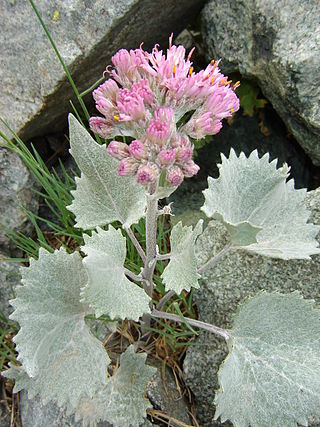
Adenostyles is a genus of flowering plants in the sunflower family Asteraceae, and of the tribe Senecioneae. It was described as a genus in 1816. Adenostyles occur in the temperate climates of the northern hemisphere, mainly in Europe and Asia Minor.

Anacyclus is a genus of plants in the family Asteraceae described by Linnaeus in 1753. Annuals or herbaceous perennials, they are cultivated for their fern-like leaves on creeping, radiating stems and daisy-like flowers. They are frost-hardy but may tolerate winter temperatures below −5 °C (23 °F) if grown in well-drained soil.

Alnus cordata, the Italian alder, is a tree or shrub species belonging to the family Betulaceae, and native to the southern Apennine Mountains and the north-eastern mountains of Corsica. It has been introduced in Sicily, Sardinia, and more recently in Central-Northern Italy, other European countries and extra-European countries, where it has become naturalised.

Santolina is a genus of plants in the chamomile tribe within the sunflower family, primarily from the western Mediterranean region.
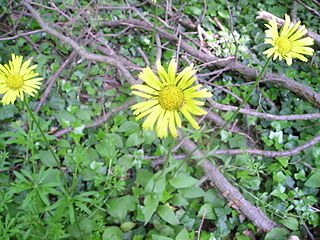
Doronicum is a genus of flowering plants in the sunflower family, known as leopard's bane. They are all herbaceous perennials native to Europe, southwest Asia and Siberia. They produce yellow, daisy-like flowerheads in spring and summer.
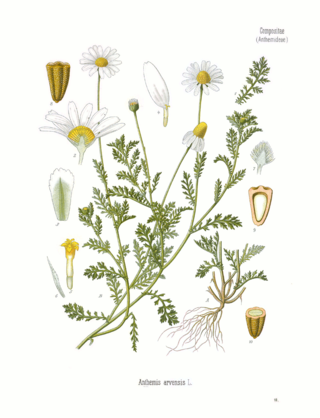
Anthemis arvensis, also known as corn chamomile, mayweed, scentless chamomile, or field chamomile is a species of flowering plant in the genus Anthemis, in the aster family. It is used as an ornamental plant.

Eupatorium cannabinum, commonly known as hemp-agrimony, or holy rope, is a herbaceous plant in the family Asteraceae. It is a robust perennial native to Europe, NW. Africa, Turkey, Syria, Iran, Iraq, Jordan, the Caucasus and Central Asia. It is cultivated as an ornamental and occasionally found as a garden escape in scattered locations in China, the United States and Canada. It is extremely attractive to butterflies, much like buddleia.

Senecio squalidus, known as Oxford ragwort, is a flowering plant in the daisy family Asteraceae. It is a yellow-flowered herbaceous plant, native to mountainous, rocky or volcanic areas, that has managed to find other homes on man-made and natural piles of rocks, war-ruined neighborhoods and dry-stone walls. These habitats resemble its well drained natural rocky homeland. The plants have spread via the wind, rail and the activities of botanists. The travels of this short-lived perennial, biennial, or winter annual make it a good subject for studies of the evolution and ecology of flowering plants.

Ampelodesmos is a genus of Mediterranean plants in the grass family, which is known by the common names stramma, Mauritania grass, rope grass, and dis(s) grass. It is classified in its own tribe Ampelodesmeae within the grass subfamily Pooideae.

Hieracium lachenalii, also known as common hawkweed or yellow hawkweed, is a species of plant in the tribe Cichorieae within the family Asteraceae. It is native to Europe but has become established as a weed in Australia and parts of North America. The species was widely known for many years as H. vulgatum, but more recent studies have indicated that the two names represent the same species. The name H. lachenalii was coined in 1802, H. vulgatum in 1819, so the older name is to be used.
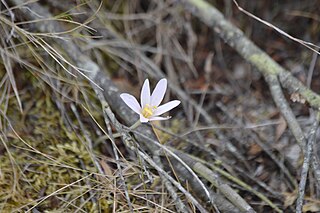
Colchicum corsicum is a species of flowering plant in the Colchicaceae family. It is native to the islands of Corsica and Sardinia in the Mediterranean.
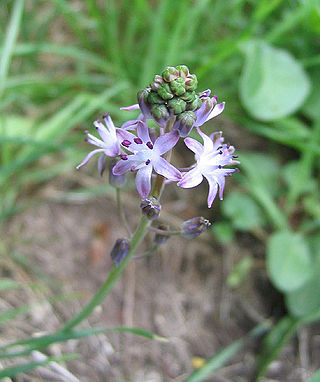
Prospero is a genus of bulbous flowering plants in the family Asparagaceae, subfamily Scilloideae. It is distributed in Europe, around the Mediterranean, and through the Middle East to the Caucasus.

Esprit Requien was a French naturalist, who made contributions in the fields of conchology, paleontology and especially botany.

Ocnogyna corsicum is a moth of the family Erebidae. It was described by Jules Pierre Rambur in 1832.

Doronicum plantagineum, the plantain-leaved leopard's-bane or plantain false leopardbane, is a European plant species in the sunflower family. It is native to southeastern Europe from Greece and Italy to Ukraine and the Czech Republic. There are reports of the species being naturalized in the State of Oregon in the northwestern United States.

Myagrum, muskweed or musk weed, is a genus of flowering plants in the family Brassicaceae. It has only one species, Myagrum perfoliatum, native to Europe and the Middle East, and an introduced weed in North America, South America, Australia and other places in Asia. It is sister to Isatis.

Himantoglossum robertianum is a species of flowering plant in the orchid family (Orchidaceae) native to the Mediterranean Basin.
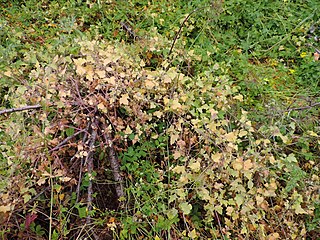
Drusa is a monotypic genus of flowering plants belonging to the family Apiaceae. It has one known species, Drusa glandulosa.



















